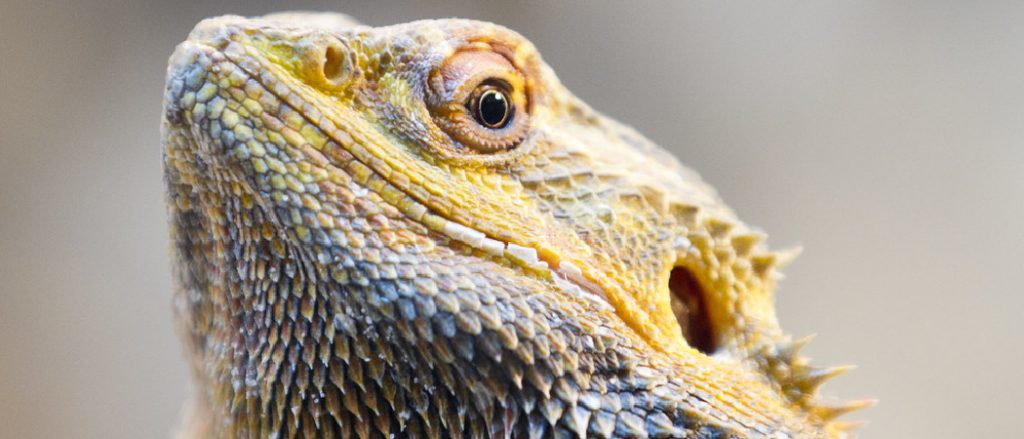Your bearded dragon may not be shedding due to improper diet or low humidity levels in its enclosure. This can lead to shedding problems.

Bearded dragons, known for their unique appearance and friendly nature, are popular reptile pets. Shedding is a natural process for them, where they shed old skin to accommodate their growth. However, if your bearded dragon is not shedding, it could be concerning.
We will explore the possible reasons why your bearded dragon is not shedding and provide solutions to help promote a healthy shedding process. By understanding the causes and taking appropriate measures, you can ensure the well-being of your bearded dragon. So, let’s dive into the world of bearded dragon shedding and address the issue at hand.
Understanding The Shedding Process
Understanding the shedding process of bearded dragons is crucial for pet owners. If your bearded dragon is not shedding, it could be due to various factors, such as poor nutrition or inadequate humidity levels in their habitat. Ensure you provide the right conditions to support their shedding process and overall health.
Understanding the Shedding Process The shedding of skin is a natural process for bearded dragons, just like it is for other reptiles. Shedding allows them to grow, heal wounds, and replace old or damaged skin. As a bearded dragon owner, it is essential to understand the shedding process to ensure the health and well-being of your pet. In this section, we will explore the natural shedding cycle in bearded dragons and the factors that can affect the shedding process.
The Natural Shedding Cycle In Bearded Dragons
Bearded dragons, like most reptiles, shed their skin periodically throughout their lives. This shedding process, known as ecdysis, occurs as bearded dragons grow and their old skin becomes too tight. Understanding the natural shedding cycle can help you anticipate and assist your bearded dragon during this time. During the shedding cycle, bearded dragons go through several stages. First, you may notice a change in their behavior. They may become more restless or exhibit increased scratching or rubbing against objects. These behaviors indicate that your bearded dragon is preparing to shed its skin. After the behavioral changes, your bearded dragon will enter the next stage, known as pre-shedding. This stage is characterized by a dulling of the skin’s color and a slight whitening. During this time, the skin is loosening, and the new layer beneath is forming. The actual shedding process occurs when your bearded dragon begins to slough off the old skin. You may notice patches of old skin peeling away, or your bearded dragon may shed in larger pieces. The shedding process usually starts around the head and neck area and progresses down the body. Once the shedding is complete, your bearded dragon will reveal its fresh, vibrant skin underneath. At this point, it is essential to provide your bearded dragon with proper hydration and a suitable environment to ensure the health of its new skin.
Factors That Can Affect The Shedding Process
While shedding is a natural process, there are several factors that can affect the shedding process in bearded dragons. Understanding these factors can help you identify and address any issues that may arise. 1. Humidity Levels: Bearded dragons require appropriate humidity levels to aid in the shedding process. Insufficient humidity can cause dry skin, leading to difficulties in shedding. On the other hand, excessive humidity may create a damp environment, which can promote the growth of harmful bacteria. 2. Diet: A balanced diet plays a crucial role in promoting healthy shedding. Inadequate nutrition can affect the overall health and condition of your bearded dragon’s skin. Ensure that your pet’s diet includes a variety of vegetables, fruits, and protein sources to support optimal shedding. 3. Environmental Conditions: The temperature and lighting conditions in your bearded dragon’s habitat can impact shedding. Adequate heat and UVB lighting are necessary for maintaining the health of your pet’s skin. Incorrect temperatures or inadequate exposure to UVB rays can disrupt the shedding process. 4. Illness or Stress: Any underlying illness or stress can affect the shedding process in bearded dragons. If your bearded dragon is experiencing difficulties shedding or if you notice any abnormalities, it is crucial to consult with a reptile veterinarian to rule out any health issues. By understanding the natural shedding cycle in bearded dragons and the factors that can affect the process, you can ensure that your pet remains healthy and comfortable during this time. Providing a suitable environment, maintaining proper hydration, and addressing any potential issues promptly will contribute to a successful shedding experience for your bearded dragon. Remember to observe your pet closely and seek professional advice when necessary.

Credit: www.reddit.com
Common Reasons For Difficult Shedding
Shedding is a natural process for bearded dragons, allowing them to grow and regenerate their skin. However, there are times when a bearded dragon may experience difficulties during shedding. Understanding the common reasons for difficult shedding can help you identify and address the issue promptly, ensuring the health and well-being of your scaly friend.
Improper Humidity Levels
One of the primary factors that affect shedding is the humidity level within the bearded dragon’s enclosure. Maintaining the right level of humidity is crucial for facilitating the shedding process. When the humidity is too low, it can cause the skin to become dry and stubbornly adhere to the bearded dragon’s body. On the other hand, excessively high humidity can lead to fungal or bacterial infections.
To provide optimal shedding conditions, ensure that the humidity levels in the enclosure are within the recommended range of 30% to 40%. You can monitor the humidity using a hygrometer, a device specifically designed to measure moisture levels. If the humidity falls below or exceeds the ideal range, make the necessary adjustments by misting the enclosure with water or using a reptile fogger.
Underlying Health Issues
In some cases, difficult shedding may be a symptom of an underlying health issue affecting your bearded dragon. Certain medical conditions, such as retained shed or dysecdysis, can hinder the shedding process. Retained shed occurs when the old skin does not fully detach from the new skin, resulting in patches that stick to the bearded dragon’s body. Dysecdysis, on the other hand, refers to abnormal shedding patterns or difficulties shedding altogether.
If you notice persistent difficulties with shedding, it is crucial to consult a reptile veterinarian. They can examine your bearded dragon and identify any potential health issues that may be causing the problem. Early diagnosis and treatment can help prevent complications and ensure a successful shedding process.
Poor Nutrition
Nutrition plays a significant role in maintaining overall health, including proper shedding, in bearded dragons. Inadequate nutrition can lead to various complications, including shedding difficulties. Specifically, a deficiency in essential nutrients such as vitamins A and E can negatively affect the skin’s health and shedding process.
Ensure that your bearded dragon’s diet consists of a balanced and varied selection of proper foods. Feed them a combination of insects, fresh greens, and occasional fruits according to their age and dietary requirements. Additionally, consider adding reptile-specific vitamin and mineral supplements to their diet to ensure they receive all the necessary nutrients. A well-rounded diet promotes healthy skin and facilitates the shedding process.
Tips For Helping Your Bearded Dragon Shed
Help your bearded dragon with shedding by providing a proper living environment, maintaining humidity levels, offering regular baths, and ensuring a balanced diet to prevent shedding issues.
Providing The Right Humidity And Temperature
Sustaining the ideal humidity and temperature levels is crucial for helping your bearded dragon shed properly. Bearded dragons are native to the arid regions of Australia and require specific environmental conditions to facilitate shedding.
To ensure the correct humidity, maintain a humidity level between 30% to 40% in their enclosure. This can be accomplished by frequently misting the terrarium or investing in a humidifier if necessary.
Equally important is maintaining an appropriate temperature gradient. The enclosure should have a warm side and a cool side, with the warm side reaching 90°F to 95°F during the day. The cool side should be around 75°F to 80°F to provide a comfortable environment for your bearded dragon.
Remember, maintaining the right humidity and temperature levels ensures a healthy and comfortable shedding process for your bearded dragon.
Assisting With The Shedding Process
While bearded dragons typically shed on their own, there are certain measures you can take to assist them in the shedding process.
Regular baths can help loosen any stubborn shed. Fill a shallow container with warm water and let your bearded dragon soak for about 15 minutes. Gently rub their skin to help remove any loosened skin.
Applying a moisturizer can also help soften the skin and alleviate any discomfort during shedding. Use a reptile-safe moisturizer and apply it directly to their skin after the bath. This will assist in the shedding process and prevent any potential tight skin or retained shed.
Improving The Diet And Nutrition
Proper nutrition plays a critical role in the shedding process of your bearded dragon. Ensuring they receive a well-balanced diet will promote healthy skin and shedding.
Include nutrient-rich foods in their diet, such as dark leafy greens, vegetables, and occasional fruit treats. These foods are packed with essential vitamins and minerals that aid in skin health.
Supplements can also enhance their nutritional intake. Calcium and multivitamin supplements should be dusted onto their food a few times a week, as recommended by a reptile veterinarian.
Additionally, ensure your bearded dragon has access to clean, fresh water at all times. Proper hydration is vital for overall health, including the shedding process.
By following these tips for helping your bearded dragon shed, you can ensure a smooth and healthy shedding process for your scaly friend.

Credit: www.reddit.com

Credit: 239flies.com
Frequently Asked Questions Of Why Is My Bearded Dragon Not Shedding
Why Is My Bearded Dragon Not Shedding?
Bearded dragons may not shed due to inadequate humidity levels in their enclosure. Another possible reason could be insufficient dietary intake of vitamins and minerals. It is also possible that your bearded dragon is not shedding because it is not getting enough natural sunlight.
Ensure you are providing the right conditions for shedding and consult a veterinarian if shedding problems persist.
How Often Do Bearded Dragons Shed?
Bearded dragons shed their skin multiple times throughout their life, typically every few months. The frequency of shedding can vary depending on the age and growth rate of the dragon. Younger bearded dragons shed more frequently than adults. If you notice abnormal shedding patterns or excessive difficulty in shedding, it is advisable to consult a veterinarian.
What Are The Signs Of Shedding Issues In Bearded Dragons?
Signs of shedding issues in bearded dragons include retained shed on toes or tail, prolonged shedding process, and irritations or wounds on the skin. If you notice these signs, it may indicate a problem with shedding and you should provide proper care and conditions to help your bearded dragon shed its skin effectively.
Consulting a veterinarian is recommended if issues persist.
How Can I Help My Bearded Dragon With Shedding?
You can help your bearded dragon with shedding by providing a proper humidity level in its enclosure, around 30-40%. Ensure that you provide a shedding box or rough surfaces for the dragon to rub against. Regular baths can also help soften the skin and facilitate shedding.
Mist the enclosure daily and provide a balanced diet with proper vitamins and minerals to support healthy shedding.
Conclusion
To sum up, understanding why your bearded dragon is not shedding is essential to ensure its health and well-being. By addressing factors such as humidity levels, diet, and overall care, you can support the shedding process and prevent any potential complications.
Regular observation and providing the necessary conditions will help your bearded dragon shed its skin successfully and maintain a healthy appearance. Remember, keeping your reptile friend comfortable and well-cared for is key to their overall happiness.


